DOA Estimation for Underwater Target by Active Detection on Virtual Time Reversal Using a Uniform Linear Array
Abstract
:1. Introduction
- (1)
- An ADVTR Capon method is proposed to improve the performance of DOA estimation at low SNR;
- (2)
- The model of conventional multipath and ADVTR multipath for ULA are established based on underwater acoustics propagation theory and array signal processing theory;
- (3)
- In contrast with the method in [50] which is only confirmed through simulation, the performance of ADVTR Capon algorithm is verified and analyzed by simulation and tank experiment;
- (4)
2. The Principle of ADVTR
3. Multipath DOA Estimation Model for ULA Based on ADVTR
3.1. Multipath Model Diagram for ULA
3.2. Conventional Multipath DOA Model for ULA
3.3. ADVTR Multipath DOA Model for ULA
4. DOA Estimation Algorithm
4.1. Spatial Smoothing Algorithm
4.2. Conventional Multipath Capon Algorithm
4.3. ADVTR Capon Algorithm
4.4. Spatial Smoothing Capon and ADVTR Capon Algorithm
4.5. Computational Complexity of Smoothing Capon and ADVTR Capon Algorithm
5. Simulation Results
- (1)
- Relative to the Capon algorithm, the ADVTR Capon algorithm can estimate accurately the expected value of the target, whose energy of the main lobe is far higher than its corresponding sidelobes and resolution is higher whether the target is at 0° or −5°. Taking a SNR of −10 dB plotted in Figure 6b when target is at −5° as an example, we can find that ADVTR Capon estimator has three peaks which correspond to the order of the multipath, whereas the conventional Capon estimator has only one peak and other two pieces of multipath information are lost. In addition, the ADVTR Capon estimator is more accurate with the highest peak in its spectrum observed at −5°, much closer to the simulated DOA of 4.998° and with much finer resolution (smaller lobes). The conventional Capon DOA estimator has a value of −3.769°.
- (2)
- The main reason for the result (1) is that relative to the conventional Capon algorithm, the operation of TR and re-transmitting to the channel in ADVTR is performed in the computer, it will be focused virtually on the target according to the focusing characteristics of TR. The process is equivalent to the beamforming process used in the array signal processing, but TR method can focus the beam towards the DOA taking advantage of multipath and its adaptive focusing characteristic, thus the energy focusing on the target is greater than beamforming. Therefore, the DOA estimation angle is more accurate when ADVTR is introduced.
- (3)
- With the change of SNR from 0 dB to −20 dB, the relations between main lobe and sidelobes for both the Capon and ADVTR Capon algorithms are the same that the energy of the sidelobes is higher and higher, and is getting closer to the main lobe. The difference is that the resolution for Capon algorithm is getting lower and lower, and the estimation deviation is more and more greater. However, the resolution for ADVTR Capon is almost not affected, and the target angle can be estimated without bias.
- (4)
- For the ADVTR method, the variation is mainly concentrated on the relation between the main lobe and sidelobes when SNR varies, and the main lobe energy can be accurately focused on the direct-path, so the estimated DOA values are almost unbiased. Because of above reasons the root mean square error (RMSE) is not analyzed. The main reason for this result is that the emphasis of this paper is the performance improvement of the Capon DOA estimation algorithm when the ADVTR method is introduced, rather than the channel estimation method, so the channel used in the focusing is the same as active detection one in the simulation and the channel estimation process is not carried out so that the effect of focusing is very ideal. If the channel estimation process is added before the virtual focusing is implemented in the virtual time reversal experiment, the focusing effect may go to the bad, and the result of the DOA estimation will be affected.
6. Experiment Results
7. Conclusions and Future Work
- (1)
- The DOA estimation in this paper is concentrated upon a single target, so the multi-objective estimation on TR will be carried out in the future research.
- (2)
- The location of underwater target can be achieved combining range estimator on TR with DOA estimator in this paper, and the lake experimental research will be carried out in the future.
- (3)
- The deduction in the paper is based on the narrow band signal, and the DOA estimation of broadband signal is the future research work.
- (4)
- The Capon algorithm is applied for DOA estimation in this paper, and other popular algorithms such as MUSIC will be studied in the future work.
Author Contributions
Funding
Acknowledgments
Conflicts of Interest
References
- Van Trees, H.L. Optimal Array Processing Theory. Part IV of Detection, Estimation, and Modulation Theory; John Wiley & Sons, Inc.: New York, NY, USA, 2002. [Google Scholar]
- Wang, B.; Wang, W.; Gu, Y.I.; Lei, S.J. Underdetermined DOA Estimation of Quasi-Stationary Signals Using a Partly-Calibrated Array. Sensors 2017, 17, 702. [Google Scholar] [CrossRef] [PubMed]
- Donoho, D.L. Compressed sensing. IEEE Trans. Inform. Theory 2006, 52, 1289–1306. [Google Scholar] [CrossRef]
- Tsaig, Y.; Donoho, D.L. Extensions of compressed sensing. Signal Process. 2006, 86, 549–571. [Google Scholar] [CrossRef]
- Fortunati, S.; Grasso, R.; Gini, F.; Greco, M.S.; Lepage, K. Single-snapshot DOA estimation by using Compressed Sensing. EURASIP J. Adv. Signal Process. 2014, 2014, 120. [Google Scholar] [CrossRef]
- Kang, C.Y.; Li, Q.Y.; Jiao, Y.M.; Li, J.; Zhang, X.H. Direction of arrival estimation and signal recovery for underwater target based on compressed sensing. In Proceedings of the 8th International Congress on Image and Signal Processing (CISP 2015), Shenyang, China, 14–16 October 2015; pp. 1277–1282. [Google Scholar]
- Guo, M.R.; Tao, C.; Ben, W. An Improved DOA Estimation Approach Using Coarray Interpolation and Matrix Denoising. Sensors 2017, 17, 1140. [Google Scholar] [CrossRef] [PubMed]
- Li, W.X.; Zhang, Y.; Lin, J.Z.; Guo, R.; Chen, Z.P. Wideband Direction of Arrival Estimation in the Presence of Unknown Mutual Coupling. Sensors 2017, 17, 230. [Google Scholar] [CrossRef] [PubMed]
- Daeipour, E.; Blair, W.D.; Bar-Shalom, Y. Bias Compensation and Tracking with Monopulse Radars in the Presence of Multipath. IEEE Trans. Aerosp. Electron. Syst. 1997, 33, 863–882. [Google Scholar] [CrossRef]
- Zhang, R.N.; Wang, S.C.; Lu, X.F.; Duan, W.M.; Cai, L. Two-dimensional DOA estimation for multipath propagation characterization using the array response of PN-sequences. IEEE Trans. Wirel. Commun. 2016, 15, 341–356. [Google Scholar] [CrossRef]
- Fink, M. Time reversal of ultrasonic fields. Part I: Basic principles. IEEE Trans. Ultrason. Ferroelectron. Freq. Contr. 1992, 39, 555–566. [Google Scholar] [CrossRef] [PubMed]
- Moura, J.M.F.; Jin, Y.W. Detection by time reversal: Single antenna. IEEE Trans. Signal Process. 2007, 55, 187–201. [Google Scholar] [CrossRef]
- Fink, M. Time reversed acoustics. Phys. Today 1997, 50, 34–40. [Google Scholar] [CrossRef]
- Fink, M. Time-reversed acoustics. Sci. Am. 1999, 91–97. [Google Scholar] [CrossRef]
- Fink, M.; Prada, C. Acoustics time-reversed mirrors. Inverse Probl. 2001, 17, R1–R38. [Google Scholar] [CrossRef]
- Fink, M.; Prada, C.; Wu, F.; Cassereau, D. Self focusing in inhomogeneous media with time reversal acoustic mirrors. In Proceedings of the IEEE Ultrasonics Symposium, Montreal, QC, Canada, 3–6 October 1989; pp. 681–686. [Google Scholar]
- Prada, C.; Wu, F.; Fink, M. The iterative time reversal mirror: A solution to self-focusing in the pulse echo mode. J. Acoust. Soc. Am. 1991, 90, 1119–1129. [Google Scholar] [CrossRef]
- Kuperman, W.A.; Hodgkiss, W.S.; Song, H.C. Phase conjugation in the ocean: Experimental demonstration of an acoustic time-reversal mirror. J. Acoust. Soc. Am. 1998, 103, 25–40. [Google Scholar] [CrossRef]
- Khosla, S.R.; Dowling, D.R. Time-reversing array retrofocusing in simple dynamic underwater environments. J. Acoust. Soc. Am. 1998, 104, 3339–3350. [Google Scholar] [CrossRef]
- Song, H.C.; Kuperman, W.A.; Hodgkiss, W.S. Iterative time reversal in the ocean. J. Acoust. Soc. Am. 1999, 105, 3176–3184. [Google Scholar] [CrossRef]
- Lerosey, G.; Rosny, J.D.; Tourin, A.; Derode, A.; Montaldo, G.; Fink, M. Time reversal of electromagnetic waves. Phys. Rev. Lett. 2004, 92, 194301. [Google Scholar] [CrossRef] [PubMed]
- Henty, B.E.; Stancil, D.D. Multipath enabled super-resolution for RF/microwave communication using phase-conjugate arrays. Phys. Rev. Lett. 2004, 93, 243904. [Google Scholar] [CrossRef] [PubMed]
- Devaney, A.J.; Marengo, E.A.; Gruber, F.K. Time-reversal-based imaging and inverse scattering of multiply scattering point targets. J. Acoust. Soc. Am. 2005, 118, 3129–3138. [Google Scholar] [CrossRef]
- Sabra, K.G.; Roux, P.; Song, H.C.; Hodgkiss, W.S.; Kuperman, W.A. Experimental demonstration of iterative time-reversed reverberation focusing in a rough waveguide: Application to target detection. J. Acoust. Soc. Am. 2006, 120, 1305–1314. [Google Scholar] [CrossRef]
- Li, C.X.; Xu, W.; Li, J.L.; Gong, X.Y. Time-Reversal Detection of Multidimensional Signals in Underwater Acoustics. IEEE J. Ocean. Eng. 2011, 36, 61–71. [Google Scholar] [CrossRef]
- Jin, Y.W.; Moura, J.M.F. Time-Reversal Detection Using Antenna Arrays. IEEE Trans. Signal Process. 2009, 57, 1396–1414. [Google Scholar] [Green Version]
- Sheng, X.L.; Bao, X.Z.; Hui, J.Y.; Liang, G.L. Underwater passive location technology using dummy time-reversal mirror. In Proceedings of the 3rd International Conference on Image and Signal Processing (ICISP 2008), Cherbourg-Octeville, France, 1–3 July 2008; pp. 605–612. [Google Scholar]
- Yu, Z.B.; Zhao, H.F.; Gong, X.Y.; Chapman, N.R. Time-Reversal Mirror-Virtual Source Array Method for Acoustic Imaging of Proud and Buried Targets. IEEE J. Ocean. Eng. 2016, 41, 382–394. [Google Scholar]
- Edelmann, G.; Akal, T.; Hodgkiss, W.S.; Kim, S.; Kuperman, W.A.; Song, H.C. An initial demonstration underwater acoustic communication using time reversal. IEEE J. Ocean. Eng. 2002, 27, 602–609. [Google Scholar] [CrossRef]
- Wang, B.B.; Wu, Y.L.; Han, F.; Yang, Y.-H.; Liu, K.J.R. Green Wireless Communications: A Time-Reversal Paradigm. IEEE J. Select. Areas Commun. 2011, 29, 1698–1710. [Google Scholar] [CrossRef]
- Song, H.C. An Overview of Underwater Time-Reversal Communication. IEEE J. Ocean. Eng. 2016, 41, 644–655. [Google Scholar] [CrossRef]
- Foroozan, F.; Asif, A. Cramer-Rao Lower Bound for Time Reversal Active Array Direction of Arrival Estimation in Multipath Environment. In Proceedings of the 2010 IEEE ICASSP, Dallas, TX, USA, 14–19 March 2010; pp. 2646–2649. [Google Scholar]
- Abadi, S.H.; Song, H.C.; Dowling, D.R. Broadband sparse-array blind deconvolution using frequency-difference beamforming. J. Acoust. Soc. Am. 2012, 132, 3018–3029. [Google Scholar] [CrossRef] [PubMed]
- Foroozan, F.; Asif, A. Time Reversal Direction of Arrival Estimation with Cramer-Rao Bound Analysis. In Proceedings of the IEEE Globecom 2010, Miami, FL, USA, 6–10 December 2010; pp. 1–5. [Google Scholar]
- Foroozan, F.; Asif, A. Time Reversal Based Active Array Source localization. IEEE Trans. Signal Process. 2011, 59, 2655–2668. [Google Scholar] [CrossRef]
- Foroozan, F.; Asif, A. Direction Finding Algorithms for time reversal MIMO radars. In Proceedings of the 2011 IEEE SSP, Nice, France, 28–30 June 2011; pp. 433–436. [Google Scholar]
- Foroozan, F.; Asif, A. Time Reversal MIMO Radar for Angle-Doppler Estimation. In Proceedings of the 2012 IEEE SSP, Ann Arbor, MI, USA, 5–8 August 2012; pp. 860–863. [Google Scholar]
- Foroozan, F.; Asif, A.; Jin, Y.W. Cramer-Rao bounds for time reversal MIMO radars with multipath. IEEE Trans. Aerosp. Electron. Syst. 2016, 52, 137–154. [Google Scholar] [CrossRef]
- Sajjadieh, M.H.S.; Asif, A. Compressive Sensing Time Reversal MIMO Radar: Direction and Doppler Frequency Estimation. IEEE Signal Process. Lett. 2015, 22, 1283–1287. [Google Scholar] [CrossRef]
- Fu, Y.Q.; Liu, W.; Bai, R.J.; Li, J.; Wang, J. A Novel Virtual Time Reversal Method for Passive Direction of Arrival Estimation. Math. Probl. Eng. 2015, 2015, 1–12. [Google Scholar] [CrossRef]
- Ciuonzo, D.; Romano, G.; Solimene, R. Performance Analysis of Time-Reversal MUSIC. IEEE Trans. Signal Process. 2015, 63, 2650–2662. [Google Scholar] [CrossRef]
- Ciuonzo, D.; Rossi, P.S. Noncolocated Time-Reversal MUSIC: High-SNR Distribution of Null Spectrum. IEEE Signal Process. Lett. 2017, 24, 397–401. [Google Scholar] [CrossRef] [Green Version]
- Ciuonzo, D.; Rossi, P.S. On the asymptotic distribution of time-reversal MUSIC null spectrum. Dig. Signal Process. 2017, 69, 50–58. [Google Scholar] [CrossRef]
- Borcea, L.; Papanicolaou, G.; Tsogka, C.; Berryman, J. Imaging and time reversal in random media. Inverse Probl. 2002, 18, 1247–1279. [Google Scholar] [CrossRef] [Green Version]
- Shi, G.; Nehorai, A. Maximum likelihood estimation of point scatterers for computational time-reversal imaging. Commun. Inf. Syst. 2005, 5, 227–256. [Google Scholar] [Green Version]
- Zeng, X.L.; Yang, M.L.; Chen, B.X.; Jin, Y.W. Low Angle Direction of Arrival Estimation by Time Reversal. In Proceedings of the 2017 IEEE ICASSP, New Orleans, LA, USA, 5–9 March 2017; pp. 3161–3165. [Google Scholar]
- Silva, A.; Jesus, S.; Gomes, J.; Barroso, V. Underwater acoustic communication using a virtual electronic time-reversal mirror approach. In Proceedings of the 5th European Conference on Underwater Acoustics, Lyon, France, 10–13 July 2000; Volume V. [Google Scholar]
- Yang, F.Z.; Wang, H.Y.; Shen, X.H.; Jing, H.X. Super-direction element distribution model of NLA based on TR. J. Shanghai Jiao Tong Univ. 2013, 47, 1907–1910. [Google Scholar]
- Shao, J.F.; Zhang, X.M.; Liu, Y.H.; Yang, F.Z. Estimation of Time Reversal Target DOA over Underwater Acoustic Multipath Time-varying Channel. In Proceedings of the 2014 IEEE China SIP, Xi’an, China, 9–13 July 2014; pp. 795–799. [Google Scholar]
- Yang, F.Z.; Wang, H.Y.; Shen, X.H.; Hua, F. The performance of time reversal beam-forming by linear array. In Proceedings of the 2012 IEEE China SIP, Hong Kong, China, 12–15 August 2012; pp. 650–653. [Google Scholar]
- Zhang, Z.C.; Wang, H.Y.; Liu, Z.G.; Shen, X.; Jiang, Z. A new LFM detection algorithm based on AVTR-FrFT for active sonar system. In Proceedings of the 2017 IEEE China SIP, Xiamen, China, 22–25 October 2017; pp. 1–5. [Google Scholar]
- Dowling, D.R. Acoustic pulse compression using passive phase-conjugate processing. J. Acoust. Soc. Am. 1994, 95, 1450–1458. [Google Scholar] [CrossRef]
- Zhang, Z.C.; Jiang, Z.; Wang, H.Y.; Liu, Z.G.; Jing, H.X. Combination of time-reversal focusing and Fractional Fourier Transform for detection of underwater target in multipath environments. In Proceedings of the 2017 OCEANS—Anchorage, Anchorage, AK, USA, 18–21 September 2017; pp. 1–5. [Google Scholar]
- Gu, J.J.; Wang, H.Y. Influence of underwater acoustic multipath structure on time reversal passive detection. In Proceedings of the 2012 IEEE China SIP, Hong Kong, China, 12–15 Augst 2012; pp. 779–782. [Google Scholar]
- Jia, T.Y.; Wang, H.Y.; Shen, X.H.; Liu, X.C. Direction of Arrival Estimation with Co-prime Arrays via Compressed Sensing Methods. In Proceedings of the Oceans 2016—Shanghai, Shanghai, China, 10–13 April 2016; pp. 1–5. [Google Scholar]




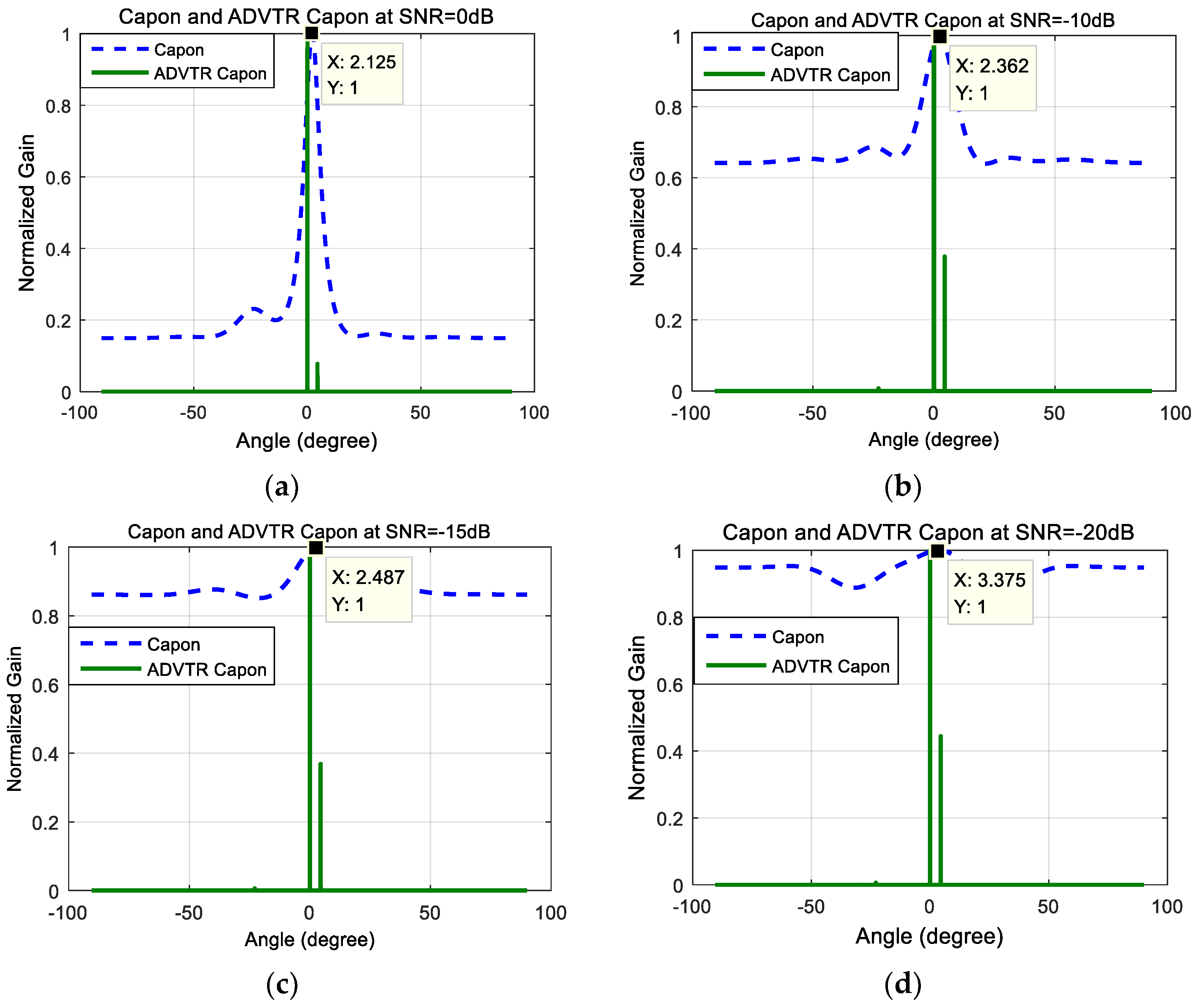
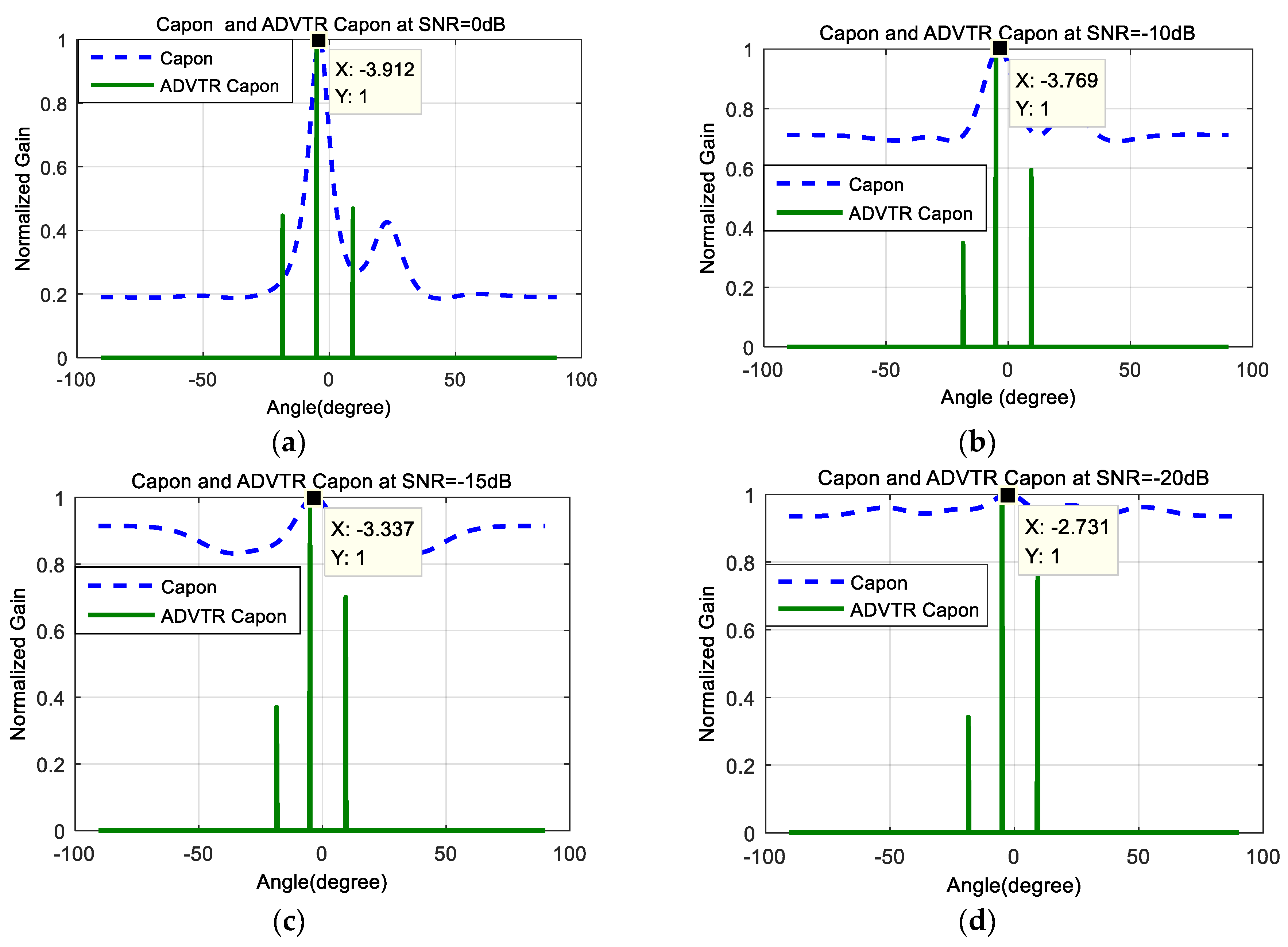
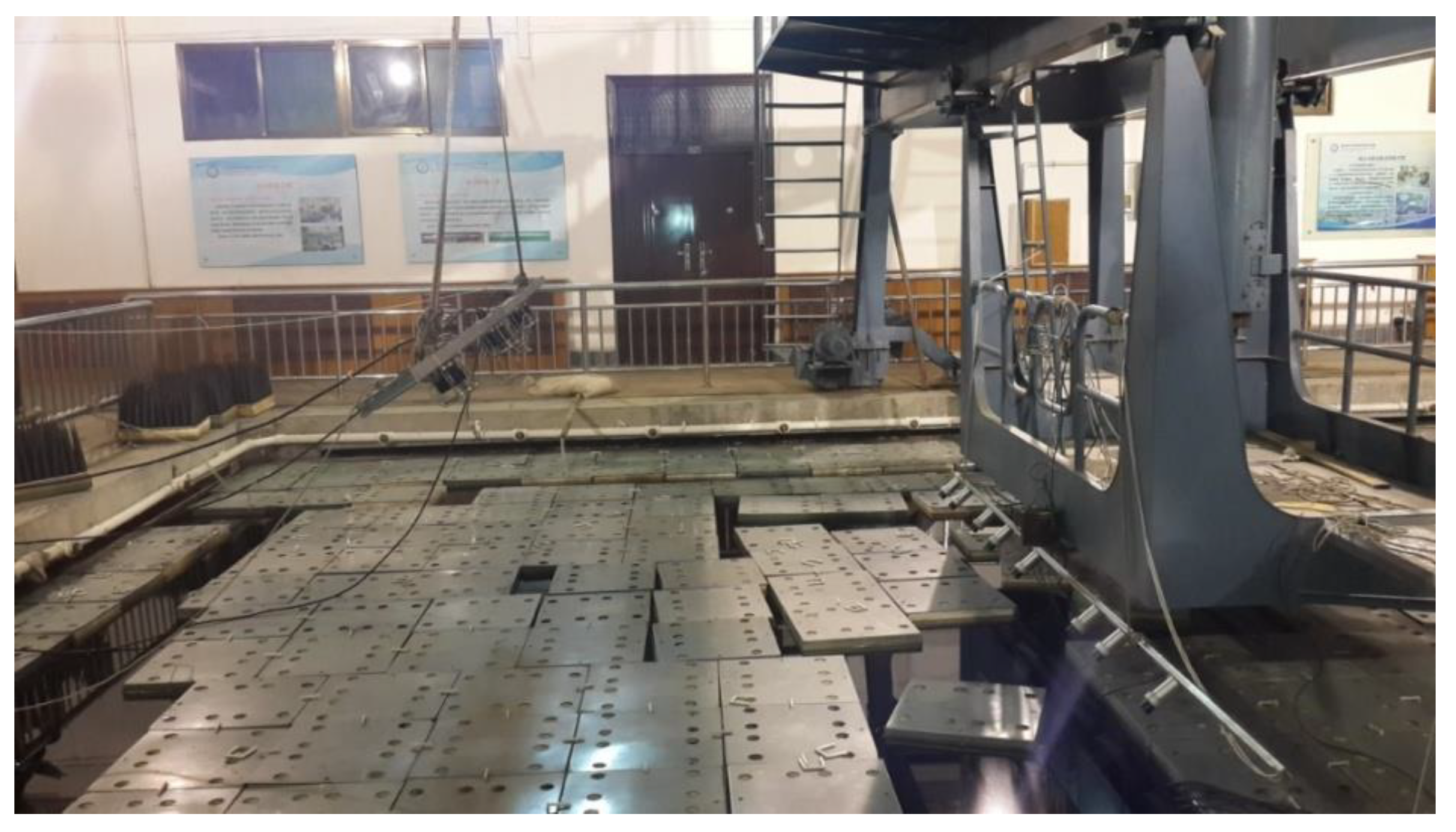
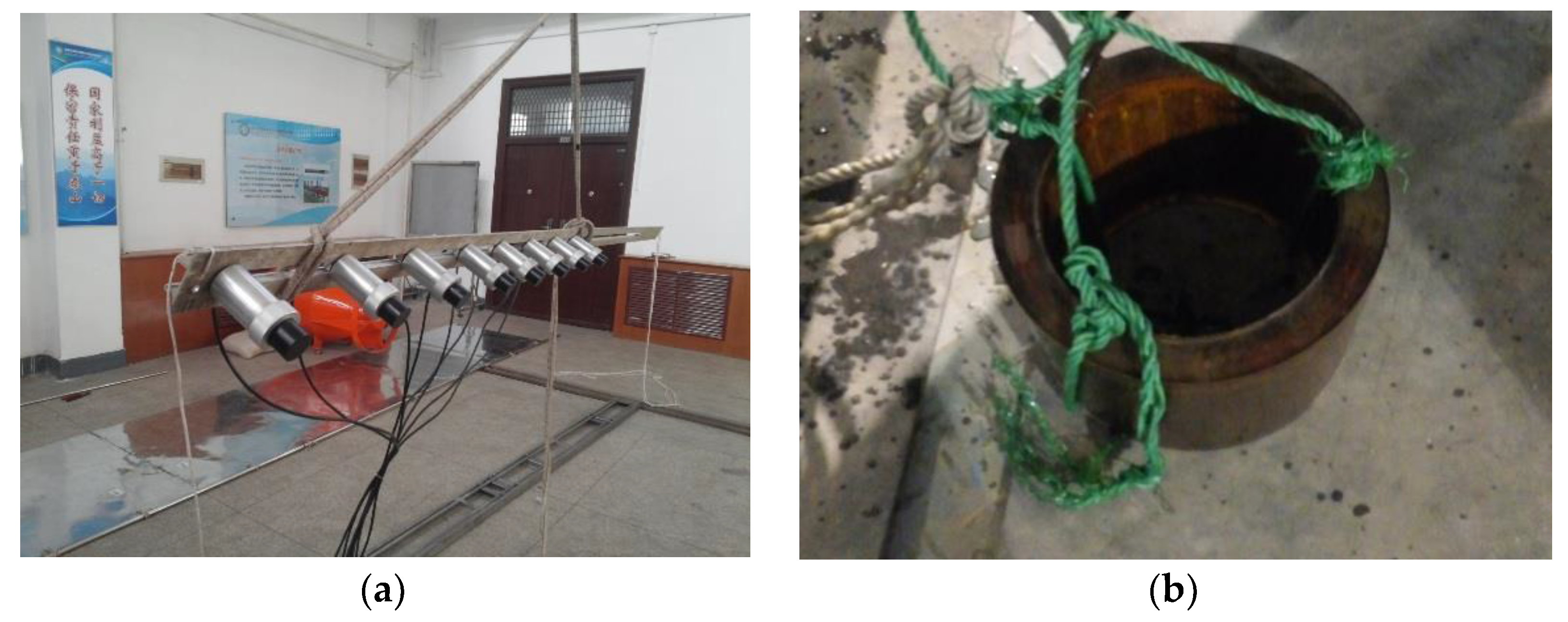

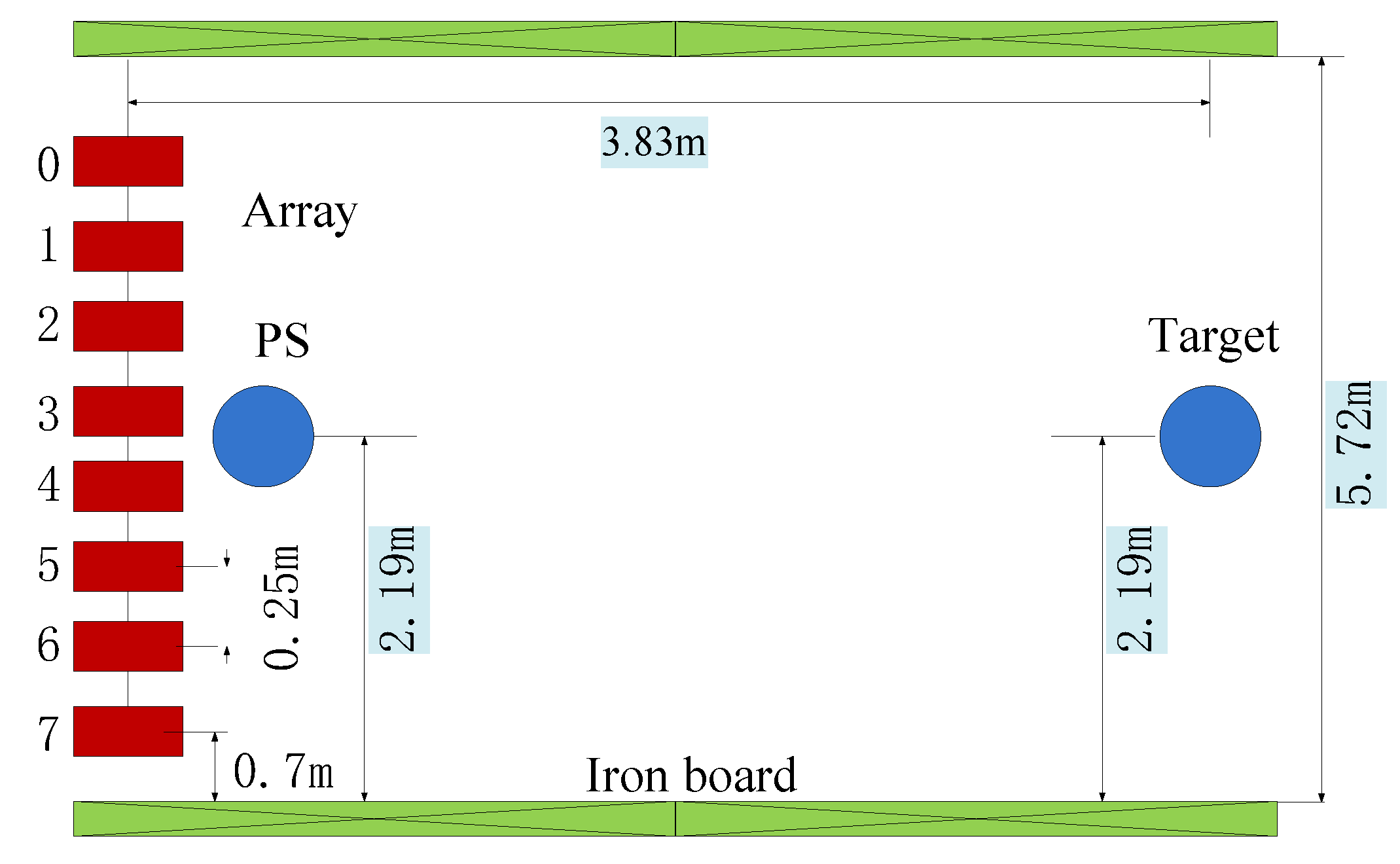

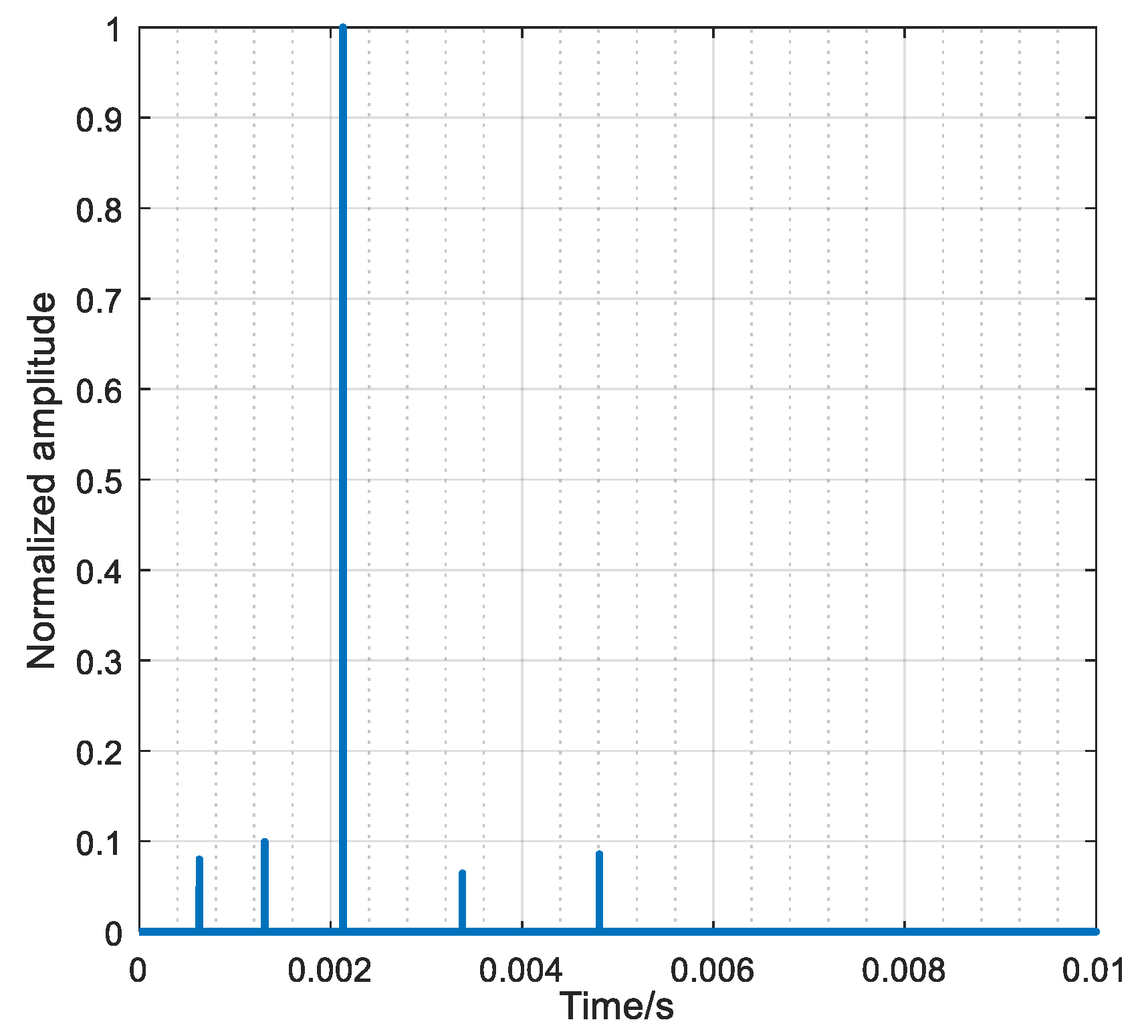

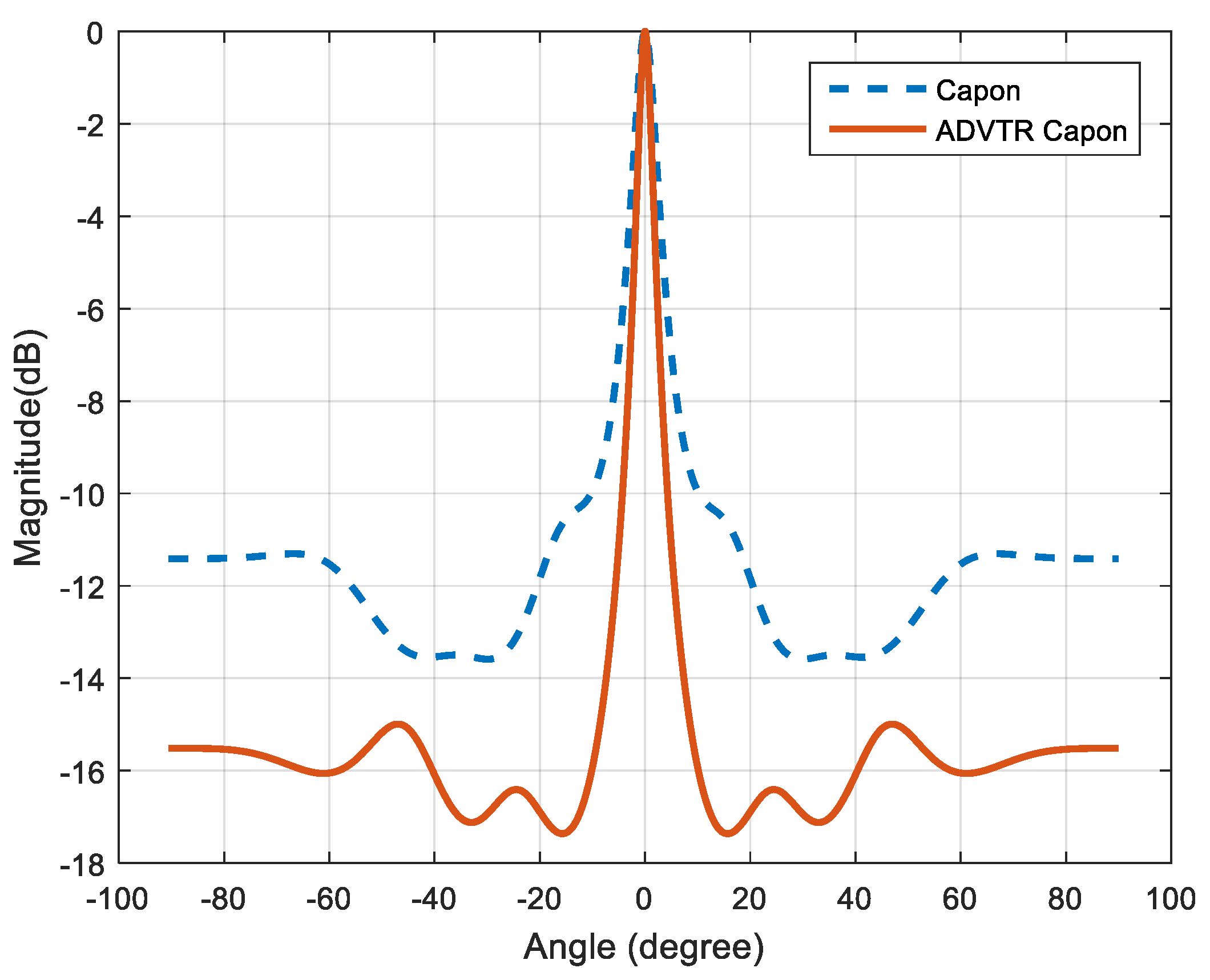
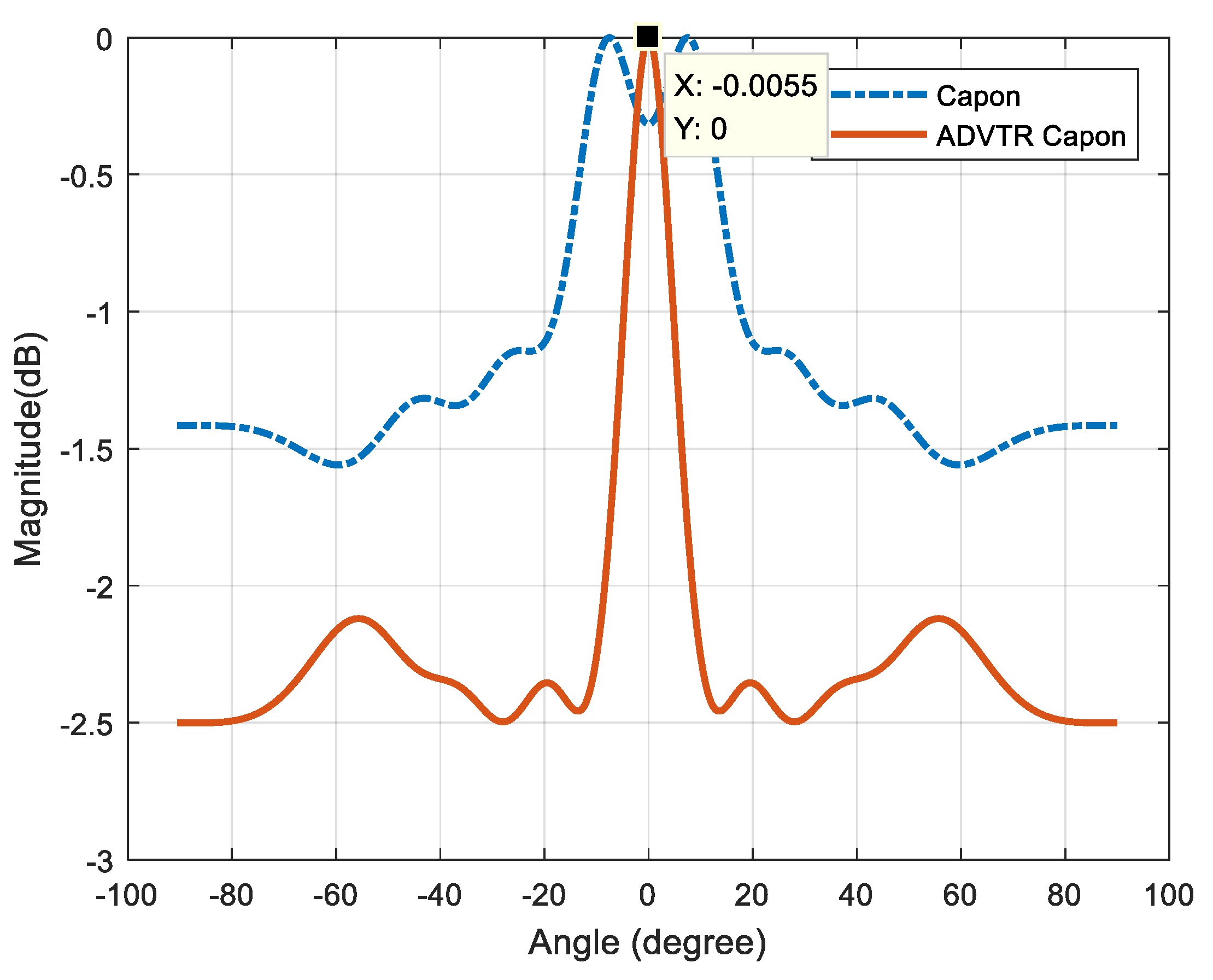

| Algorithm | Computational Complexity |
|---|---|
| Capon | |
| ADVTR Capon |
| Simulation Condition | Parameter |
|---|---|
| Attenuation | 2 (dB/m) kHz |
| Number of targets | 1 |
| Number of elements | 9 |
| Interelement spacing | 0.75 m |
| The depth of element | 75 m |
| The depth of bottom | 500 m |
| The source depth | 78 m |
| Target depth (0°) | 78 m |
| Target depth (−5°) | 253 m |
| The range | 2 km |
| Number of multipath | 3 |
| Simulation Parameter | Value |
|---|---|
| Direction of arrival | {4.458°, 0°, −22.884°} |
| Amplitude | {4.99 × 10−4, 5.0 × 10−4, 2.92 × 10−4} |
| Delay of element | {1.3372291, 1.3333348, 1.4479731} s |
| Simulation Parameter | Value |
|---|---|
| Direction of arrival | {19.396°, −4.998°, −18.498°} |
| Amplitude | {4.93 × 10−4, 4.98 × 10−4, 4.74 × 10−4} |
| Delay of element | {1.351145, 1.3386036, 1.4065851} s |
| Experiment Condition | Parameter |
|---|---|
| Distance between two pieces of iron | 5.72 m |
| Number of elements | 8 |
| Interelement spacing | 0.25 m |
| The position of elements 8 (from the bottom sheet) | 0.7 m |
| Target position (from the bottom sheet) | 2.19 m |
| PS position (from the bottom sheet) | 2.19 m |
| Target depth | 0.8 m |
| Array depth | 0.8 m |
| The range | 3.83 m |
| DOA | 0° |
| PS frequency | 3 KHz |
| Sampling frequency | 1.04 MHz |
© 2018 by the authors. Licensee MDPI, Basel, Switzerland. This article is an open access article distributed under the terms and conditions of the Creative Commons Attribution (CC BY) license (http://creativecommons.org/licenses/by/4.0/).
Share and Cite
Jing, H.; Wang, H.; Liu, Z.; Shen, X. DOA Estimation for Underwater Target by Active Detection on Virtual Time Reversal Using a Uniform Linear Array. Sensors 2018, 18, 2458. https://doi.org/10.3390/s18082458
Jing H, Wang H, Liu Z, Shen X. DOA Estimation for Underwater Target by Active Detection on Virtual Time Reversal Using a Uniform Linear Array. Sensors. 2018; 18(8):2458. https://doi.org/10.3390/s18082458
Chicago/Turabian StyleJing, Haixia, Haiyan Wang, Zhengguo Liu, and Xiaohong Shen. 2018. "DOA Estimation for Underwater Target by Active Detection on Virtual Time Reversal Using a Uniform Linear Array" Sensors 18, no. 8: 2458. https://doi.org/10.3390/s18082458
APA StyleJing, H., Wang, H., Liu, Z., & Shen, X. (2018). DOA Estimation for Underwater Target by Active Detection on Virtual Time Reversal Using a Uniform Linear Array. Sensors, 18(8), 2458. https://doi.org/10.3390/s18082458




